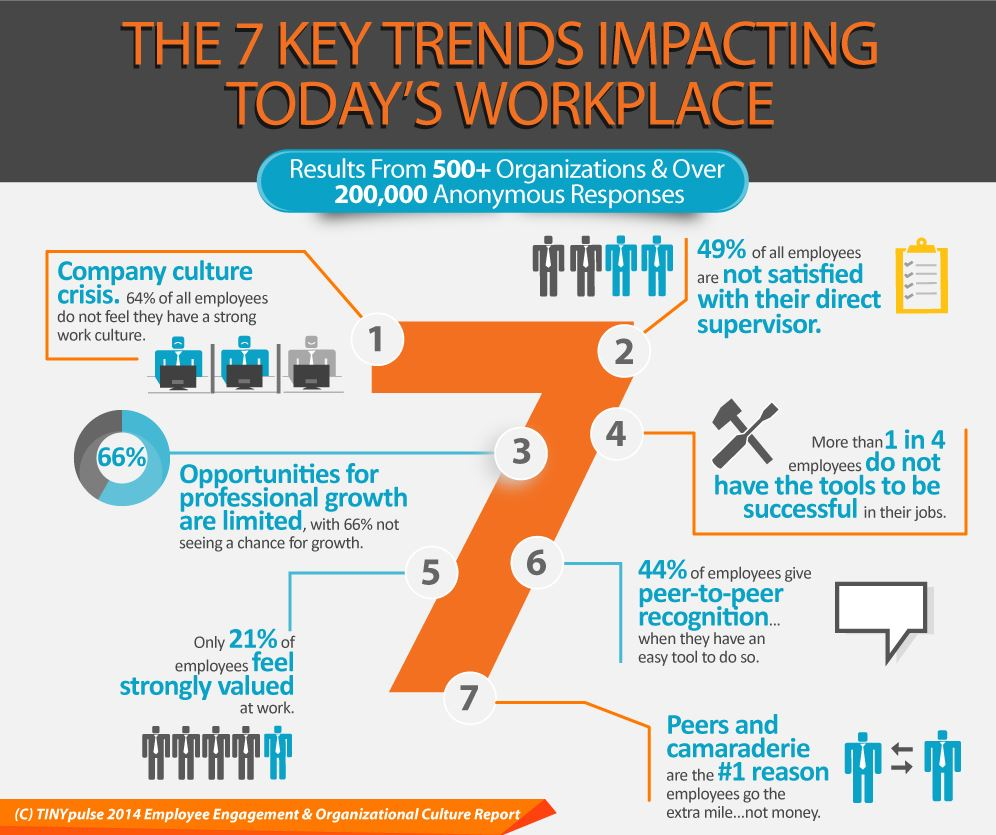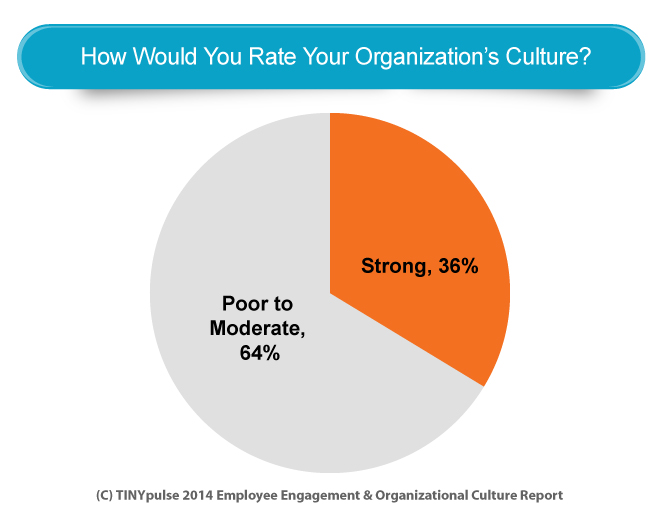The strength and makeup of your company culture has a lot to do with whether employees feel they work for an establishment that makes them feel valued, and if they’re likely to recommend it to their friends as a good place to work.
Although it’s true you can learn a lot by simply having face-to-face chats with employees, there are several company culture metrics that can offer a clear picture of how you’re doing, and where there’s room for improvement.
Related Article: Leadership of Champions: How to Actively Create Your Company Culture

Image via Tiny HR
Adaptability
It’s very important that employees feel well-equipped to handle organizational changes. Regardless of what it relates to, managers can feel they have everything necessary to handle changes with relative ease, but that sense of empowerment might not extend to other employees.
One great way to check in and see how other employees are feeling about upcoming changes is to try and get feedback in an informal way.
For example, you could have lunch catered to the office and host a casual meeting about upcoming company changes while people enjoy the meal. At the end of that session, pass out short surveys that ask people to rank how prepared they are for what’s ahead, and give them space to discuss if there are things management could do to make the transition easier.
Personal Wellness
Giving employees access to a personal wellness incentive, such as a gym membership discount, can give the impression your workplace truly cares about helping employees stay healthier. However, besides bolstering that aspect of company culture, a personal wellness program is an economically sound choice for your company.
Specifically, for every dollar a company spends on a wellness program, medical-related expenses decrease by an average of $3.27 while costs associated with absenteeism go down by about $2.73.

To check the effect at your company, track how many people use a personal wellness benefit over the course of a year, then cross-examine with company expenses linked to wellness initiatives.
Related Article: Health, Happiness and Office Design
Comfort Level of the Work Environment
Characteristics like the layout of an office and the comfort level of a room can make a big difference in whether people are able to do their jobs well and feel content during the process. Even seemingly basic features, such as temperature, can make a difference in productivity.
During cold weather, window drapes can reduce heat loss by as much as 10 percent. That means drapes may not only keep employees warmer and more focused on work, but also could cut your company’s utility bills—a double increase in efficiency.
It’s important to realize that some employees may be hesitant to come to a human resources representative if they feel like something about the workplace makes them physically uncomfortable. When it is a seemingly small problem, such as how much space there is between cubicles or whether the room frequently feels too cold, people hesitate to approach superiors about the issue because they don’t want to be seen as nitpicky.
Often, managers don’t realize there’s a problem unless several workers come to them and have the same complaint.
For that reason, it’s sometimes difficult to get metrics about workplace comfort. If you’re having trouble, think about putting a ‘suggestions box’ in a communal office area and attaching blank index cards to it. People can use those index cards to make anonymous comments about the things they like and dislike about the comfort level of their workplace, and more importantly, how to make it better for everyone.
Related Article: Why Company Culture Matters More to Employee Than Pay
Whether Employees Feel Recognized and Supported
When employees feel they are contributing positively to an organization and that those efforts are being noticed by colleagues, they’re more likely to have higher spirits and senses of self-worth. In contrast, if people feel they are getting lost in the shuffle and that no one would notice if they just stopped doing their jobs, that can bring down the productivity level of an entire team.
A study from the Harvard Business Review found middle managers are the most likely candidates to feel dissatisfied at work. There’s a wide variety of reasons for this, ranging from a perception that they are not getting fair treatment to a belief that if they were to raise an issue to a superior, it wouldn’t be properly addressed.
However, the top reason for unhappy members of middle management was poor leadership. When a company does not have a strong leadership structure, it tends to create a culture where all employees are uncommitted, not just middle managers.
You can proactively avoid such problems by taking time out to get honest feedback from workers, and also make sure those employees are kept in the loop about changes that are being made to bolster morale at work. Even something as simple as taking time out to personally thank a worker for something he did that was beyond what was expected can do a lot to improve someone’s mood and level of satisfaction towards a workplace.
Employee support is also a crucial metric, especially when new workers are brought on board or when workers get promoted to other positions. Hosting celebrations to mark such occasions is a good first step, but it’s also useful to have an open-door policy and encourage people to speak to human resource managers right away if they have a need that isn’t being met.

Image via Tiny HR
A report from last year that collected anonymous responses from more than 200,000 individuals found 64 percent of people felt the company they work for does not have a strong company culture. That’s proof if it seems your corporate culture is lacking, you’re not alone. Thankfully, the actionable strategies you’ve just read for keeping tabs on metrics should help you make positive changes in your organization that could keep employees happier, reduce turnover and make your workplace a more positive environment overall.